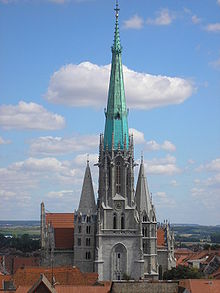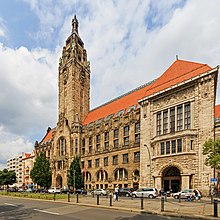Langensalza travertine
The Langensalzaer travertine is the only Thuringian travertine of the, Thuringian basin in quarries is obtained (as of 2008). It occurs near the town of Bad Langensalza in the Unstrut-Hainich district in Thuringia and originated in two phases 125,000 years ago in the Middle Pleistocene and 10,000 years ago in the Holocene .
Occurrence of the Thuringian travertine
The most important deposits of Thuringian travertine are in the Unstruttal near Bad Langensalza, Mühlhausen , Gräfentonna , Greußen and Clingen . Further deposits are located near Mühlberg, southeast of Gotha , near Kindelbrück , Bad Tennstedt , Klein- Ballhausen , in the Ilm Valley near Ehringsdorf , Taubach and Weimar and near Jena in the towns of Engerda , Winzerla and Leutra .
The occurrence of the Langensalza travertine in the Salzatal leads to rock banks in a mining relevant thickness of 0.65 to 2.10 meters. In the Unstruttal the bench height is 3 meters. The total thickness of the travertine is up to 20 meters. The deposit is relatively close to the surface and can be mined without major problems.
Langensalza travertine
Origin and description of the rock
The travertines are freshwater limestones, while the other limestones were formed in salt water. This travertine (limestone tuff and stone travertine) was deposited on the bottom of a post-glacial river. Langensalza travertine was created through precipitation processes from calcareous waters (karst springs), whereby the dead fauna and flora turned into solid limestone.
This travertine is light yellowish to brownish in color and, like all travertines, has irregularly large pores, which, however , are usually not connected by capillaries . Commercially is primed travertine offered whose pores were filled, he that resembles dense limestone.
Extraction and use
This travertine is obtained with a wire saw or the so-called Schräme , a mobile chainsaw that saws the raw blocks from the rock deposit. After its extraction, this travertine is then sawn to size using stone saws to make bricks, profiled cornices and facade panels for the respective purposes. Travertines can be filled with a spatula to close the pores, some of which are large. But they are also installed without filling. When sawing the raw blocks with gang saws, they can be sawed against the bearing if the deposit structure is to be recognizable as banding or stripes. When dividing with the bearing, denser surfaces with a smaller pore volume and no discernible banding or stripes are created. Freshly broken , travertine can be easily worked by hand as it is relatively soft in this condition. After curing, travertine is frost-resistant and can be partially polished. The polish in the open air wears off relatively quickly under the current weather conditions. A gray patina develops.
Langensalza travertine was first used at Homburg Monastery around 800, which is said to have been donated by Charlemagne, and for the west wing of Dryburg Castle , which was built in 1011 as the seat of the Lords of Salza. Since the 12th century, this travertine has been installed on almost all public buildings in Bad Langensalza, such as B. at the market church St. Bonifacii , the city fortifications and their towers, the town hall (1752), for the Kursächsische all-mile column and for the Kursächsische quarter milestone . The city's historic private houses are also at least partially made of travertine (portals, cellar vaults). The stone was easy to extract in the city, as there was a deposit there. This was located within the fortifications in the southwest of the city.
The Marienkirche in Mühlhausen was built in the 13th century. The town hall in Berlin-Charlottenburg , the facade of Bosch AG (1916/1917), the Nordsternhaus in Berlin-Schöneberg (1912) in Berlin and the administration building of the Henkell & Söhnlein sparkling wine producer (1907–1909) in Wiesbaden are made of this travertine. In 1929 Mies van der Rohe built the German pavilion at the world exhibition in Barcelona using Langensalza travertine. In the extension of the Old Reich Chancellery (1928–1930) in Berlin, the window frames were made from this travertine. The Tauentzien Palace was partially clad with Langensalza travertine, as was the Faber high-rise in Magdeburg .
After the end of the Second World War, Langensalza travertine was delivered to the planetarium in Stalingrad ( Volgograd ) in 1950/1951 and, above all , Langensalza travertine was used as part of the five-year national development program of the GDR in 1951, e.g. B. for the sports hall on Stalinallee in Berlin and the reconstruction of the train station in Magdeburg. In the GDR the stone was often used instead of natural stone up to the phase of artificial stone production, after the fall of the Wall and now (as of 2008), it is again in great demand.
See also
literature
- Ester Helena Arens: Stones with a story. 100 years of Traco Deutsche Travertin Werke 1907–2007. Edited by vd Traco GmbH, Rockstuhl Bad Langensalza, Bad Langensalza 2007.
- Andreas Fehler: The travertines of Bad Langensalza. Rockstuhl Verlag, Bad Langensalza 1998, p. 170ff.
- Karlfriedrich Fuchs: Natural stones from all over the world; discover, determine, apply. Callwey, Munich 1997, sheet. 233.
- W. Dienemann, O. Burre: The usable rocks in Germany and their deposits with the exception of coal, ores and salts. Enke-Verlag, Stuttgart 1929, p. 429ff.
Web links
- Travertine Thuringia on the website of the quarry operator Traco, Bad Langensalza
Individual evidence
Coordinates: 51 ° 6 ′ 14 ″ N , 10 ° 38 ′ 1 ″ E



